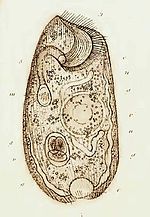Climacostomum
| Climacostomum | |
|---|---|

| |
| Climacostomum sp. | |
| Scientific classification | |
| Domain: | |
| (unranked): | |
| (unranked): | |
| Phylum: | |
| Class: | |
| Order: | |
| Family: | |
| Genus: | Climacostomum Stein,1859
|
| Species | |
|
Climacostomum virens | |
Climacostomumis a genus of unicellularciliates,belonging to the classHeterotrichea.
The genus has one well-described species,Climacostomum virens,which usually carries a symbiotic alga, a variety ofChlorellathat can be cultivated outside its host.[1]Algae-free (aposymbiotic) individuals are known, and a species that lacks algal symbionts,Climacostomum gigasMeunier 1907, has been identified, but not confirmed in recent literature.
In its cortex,Climacostomum virenshas colorless granules structurally similar to the defensive pigmentocysts found in its fellow Heterotrichs,Stentor coreuleusandBlepharisma japonicum.[2]WhenClimacostomumis threatened by a predator, such as the ciliateDileptus margaritifer,these cortical cysts release a defensive cytotoxin called Climacostol. This substance has been synthesized in the laboratory[3]and found to be highly toxic to certain species of ciliates.[4]It is believed that this toxicity is accomplished by the inhibition of mitochondrial respiration.[5]It has been shown to have toxic effects on certain human cancer cells.[6]
Appearance and characteristics
[edit]
The body is somewhat flexible but non-contractile, roughly ovoid or harp-shaped, and flattened from back to front. It has a large posteriorcontractile vacuole,and a characteristic posterior indentation (more pronounced in underfed individuals).[7]The posterior vacuole surrounds the cytoproct (anus), through which food waste is eliminated.[8]The macronucleus ofClimacostomum virensis normally long and wormlike (vermiform).Climacostomum gigasis reported to have a compact, ovoid macronucleus.[9]
The cell's most prominent feature is its large oral apparatus, which occupies most of the anterior region. This structure features an adoral zone of membranelles (AZM) partly encircling a wide oral cavity which opens into the cytopharyngeal pouch where digestive vacuoles are formed before they travel down the long, bent cytopharyngeal tube into the body of the cell.[8][10]
Climacostomumis found in fresh or brackish water, and feeds on suspended particles, such as bacteria and small flagellates.[8][10]
WhenClimacostomum virensis grown in the dark, the algal endosymbionts normally found in it are reduced in number and the cytoplasm appears colorless.[11]Peck et al. report that these are not contained within a membrane, but are in direct contact with the host's cytoplasm; however, other observers have noted the presence of perialgal vacuoles around the algae.[1][12]
Classification
[edit]
The speciesClimacostomum virenswas first described in 1833 byChristian Gottfried Ehrenberg,under the nameSpirostomum virens.In 1859,Samuel Friedrich von SteinmovedSpirostomum virensto a new genus, which he calledClimacostomum.In his Manual of Infusoria (1880),William Saville-Kentrejected Stein's genus, assigning the species instead toLeucophrys patula,which he described as synonymous with Ehrenberg'sSpirostomum virensandLeucophrys patula,as well as theTrichoda patulaof O.F. Muller.[13]However, the genus was retained by other researchers, including Alfred Kahl.[9]
In a detailed study of its physical characteristics, published in 1972, Arthur J. Repak placedClimacostomumwith the genusFabreain a new family he namedClimacostomidae.[7]
Recently, molecular analyses have shown that, while the Heterotrichea as a whole are amonophyleticgroup, the taxonClimacostomidaeisparaphyletic,the genusFabreabeing more closely related to the ciliatesEufolliculinaandMaristentorthan toClimacostomum.[14]Among the other Heterotrichs,Climacostomumappears to be most closely related toChattonidiumandCondylostoma.[15]
Video gallery
[edit]References
[edit]- ^abReisser, W.; Fischer-Defoy, D.; Staudinger, J.; Schilling, N.; Hausmann, K. (1984). "The endosymbiotic unit ofClimacostomum virens andChlorella sp. I. Morphological and physiological studies on the algal partner and its localization in the host cell".Protoplasma.119(1–2): 93–9.doi:10.1007/BF01287821.S2CID21463062.
- ^Miyake, A (2003). "Chemical defence by means of extrusive cortical granules in the heterotrich ciliate".European Journal of Protistology.39:25–36.doi:10.1078/0932-4739-00900.
- ^Abe, Yumi; Mori, Kenji (2001). "Simple Synthesis of Climacostol, a Defensive Secretion by the Ciliate Climacostomum virens".Bioscience, Biotechnology, and Biochemistry.65(9): 2110–2.doi:10.1271/bbb.65.2110.PMID11676032.
- ^Buonanno, Federico; Ortenzi, Claudio (2010)."The protozoan toxin climacostol and its derivatives: Cytotoxicity studies on 10 species of free-living ciliates".Biologia.65(4): 675–80.doi:10.2478/s11756-010-0071-1.S2CID757779.
- ^Muto, Yoshinori; Tanabe, Yumiko; Kawai, Kiyoshi; Okano, Yukio; Iio, Hideo (2010)."Climacostol inhibits Tetrahymena motility and mitochondrial respiration".Central European Journal of Biology.6:99–104.doi:10.2478/s11535-010-0100-7.
- ^Buonanno, Federico; Quassinti, Luana; Bramucci, Massimo; Amantini, Consuelo; Lucciarini, Roberta; Santoni, Giorgio; Iio, Hideo; Ortenzi, Claudio (2008). "The protozoan toxin climacostol inhibits growth and induces apoptosis of human tumor cell lines".Chemico-Biological Interactions.176(2–3): 151–64.doi:10.1016/j.cbi.2008.07.007.PMID18723007.
- ^abRepak, Arthur J. (1972). "A Redescription of Climacostomum virens (Ehrenberg) Stein and Proposal of a New Heterotrich Ciliate Family, Climacostomidae fam. N".The Journal of Eukaryotic Microbiology.19(3): 417–27.doi:10.1111/j.1550-7408.1972.tb03496.x.
- ^abcFischer-Defoy, Dorothee; Hausmann, Klaus (1982). "Ultrastructural characteristics of algal digestion by Climacostomum virens (Ciliata) (Ehrenberg) stein".Zoomorphology.100(2): 121–30.doi:10.1007/BF00310358.S2CID29838109.
- ^abCarey, Philip G. (1992).Marine interstitial ciliates: an illustrated key.Chapman and Hall. p. 160.ISBN978-0-412-40610-2.
- ^abKudo, Richard R. (1954)."Genus Climacostomum Stein".Protozoology(4th ed.). Springfield: Charles C. Thomas. p. 807.
- ^Peck, Robert; Pelvat, Bernard; Bolivar, Ignacio; Haller, Gerard (1975). "Light and Electron Microscopic Observations on the Heterotrich Ciliate Climacostomum virens".The Journal of Eukaryotic Microbiology.22(3): 368–85.doi:10.1111/j.1550-7408.1975.tb05187.x.
- ^Karajan, B; Vishnyakov, A; Tavrovskaya, M; Vasyanin, S (2007). "Infection of algae-free Climacostomum virens with symbiotic Chlorella sp. Isolated from algae-containing C. Virens".European Journal of Protistology.43(2): 141–6.doi:10.1016/j.ejop.2007.01.001.PMID17498933.
- ^Saville Kent, W.(1880)."Genus IV. Leucophrys, Ehrenberg".A Manual of the Infusoria. Vol II.London: David Bogue. pp. 587–8.OCLC8998761.
- ^Schmidt, Stephanie L.; Foissner, Wilhelm; Schlegel, Martin; Bernhard, Detlef (2007). "Molecular Phylogeny of the Heterotrichea (Ciliophora, Postciliodesmatophora) Based on Small Subunit rRNA Gene Sequences".The Journal of Eukaryotic Microbiology.54(4): 358–63.doi:10.1111/j.1550-7408.2007.00269.x.PMID17669161.S2CID33657322.
- ^Miao, Miao; Song, Weibo; Clamp, John C.; Al-Rasheid, Khaled A.S.; Al-Khedhairy, Abdulaziz A.; Al-Arifi, Saud (2009). "Further Consideration of the Phylogeny of Some" Traditional "Heterotrichs (Protista, Ciliophora) of Uncertain Affinities, Based on New Sequences of the Small Subunit rRNA Gene".Journal of Eukaryotic Microbiology.56(3): 244–50.doi:10.1111/j.1550-7408.2009.00391.x.PMID19527351.S2CID882895.
